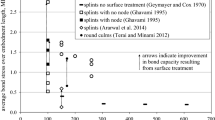Abstract
This paper describes the development of eco-friendly bamboo and wood fibre cement composites from agriculture wastes for applications in the housing and building industries, and for sustainable infrastructure regeneration. Bamboo flakes and fibres from oil palm tree fronds were produced and tested for their sugar content and effect on the setting and strength development of the portland cement matrix. To counteract the adverse effects on cement hydration, chemical accelerators, cement replacement materials or a combination of both were used in the manufacture of the composite boards. With the bamboo, the composition of the particleboard was optimized in terms of bamboo–cement ratio and the type and amount of chemical admixture to produce a composite with satisfactory strength and dimensional stability. For the production of wood fibre cement composites, cement replacement materials such as fly ash, rice husk ash and latex were used in conjunction with chemical admixtures to counteract the adverse effect on the hydration characteristics of the cement matrix. Tests were then carried out to optimize the amount and type of cement replacement material and chemical admixtures to produce boards with adequate strength and dimensional stability. All the strength and dimensional stability tests reported in the paper were carried out according to Malaysian Standard MS 934. The paper emphasizes the need for holistic design combining chemical admixtures, cement replacement materials and modern production technology to produce a wide range of cement-bonded composite boards, which will satisfy international standards and can be widely used for infrastructure regeneration.



Similar content being viewed by others
References
Swamy RN (2000) In: Rossi P, Chanvillard G (eds) Proc. of the Fifth Int RILEM Symposium on fibre reinforced concrete. BEFIB 2000. RILEM Publications S.A.R.L., France, pp 3–18
Swamy RN (ed) (1984) New reinforced concretes, concrete technology and design, vol 2. Blackie and Son, Glasgow, p 200, ISBN 0-903384-47-7
Swamy RN (ed) (1988) Natural fibre reinforced cement and concrete, concrete technology and design, vol 5. Blackie and Son, Glasgow, p 288, ISBN 0-216-92493-6
Swamy RN (1990) Proc. Second Int Conf on vegetable plants and their fibres as building materials. Chapman and Hall, London, pp 1–8
Kadir AA, Sudin R (1989) Carbohydrates in rubberwood, encyclopedia of materials science and engineering. Pergammon Press Ltd, London, pp 5399–5402
Sudin R, Zakaria MA (1992) In: Swamy RN (ed) Proc. Fourth RILEM Int Symp on fibre reinforced cement and concrete. E&FN Spon, London, pp 1128–1139
Swamy RN (ed) (1985) Developments in fibre reinforced concrete, vols. 1 and 2. Sheffield University
Swamy RN, Barr B (eds) (1989) Fibre reinforced cements and concretes – recent developments. Elsevier Applied Science, London, ISBN 1-85166-415-7
Sobral H (ed) (1990) Vegetable plants and their fibres as building materials. Chapman and Hall, London, ISBN 0-412-39250-X
Swamy RN (ed) (1992) Fibre reinforced cement and concrete. Proc. Fourth RILEM Int Symp. E&FN Spon, London, ISBN 0-419-18130-X
Gram H-E (1988) In: Swamy RN (ed) Durability of natural fibres in concrete, natural fibre reinforced cement and concrete. Blackie and Sons, Glasgow, pp 143–172
Filho RDT, Ghavami K, England GL, Scrivener K (2003) Cement Concrete Composites 25:185–196
Savastano H Jr, Warden PG, Coutts RSP (2003) Cement Concrete Composites 25:311–319
Subrahmanyam BV (1984) In: Swamy RN (ed) Bamboo reinforcement for cement matrices, new reinforced concretes. Blackie and Sons, Glasgow, pp 141–194
Robles-Austriaco L, Pama RP (1988), Bamboo reinforcement of cement and concrete, natural fibre reinforced cement and concrete. Blackie and Son, Glasgow, pp 92–142
Ghavami K (1989) Application of bamboo as low cost energy material in civil engineering. Third CIB/RILEM Symp for Low Income Housing, Mexico City, pp 526–533
Lima HC Jr, Barbosa NP, Ghavami K (1995) In: Anais do V Ebramen, Belo Horizonte MG (eds) Comportamento em Servico de Lajes de Concreto Reforcadas com Bambu, vol. II. pp 441–454
Barbosa NP, Swamy RN, Lynsdale C (eds) (2000) Sustainable construction into the next millennium: environmentally friendly and innovative cement based materials. Proc of Int Conf, Federal University of Paraiba, Brazil, pp 803
Ghavami K (2002) Proc Third Int Conf on non-conventional materials and technologies NOCMAT/3. Construction Publishing House, Vietnam, pp 54–70
Sudin R, Mohmod AL, Kasim J (1996) Bangladesh J For Sci 25(1 & 2):8–14
Mansor H, Rashih AA (1990) J Trop For Sci 2:220–226
Schwarz HG (1989) In: Moslemi AA (ed) Proc Int Conf on fibre and particleboard bonded with inorganic binders, pp 91–93
Sudin R, Shaari K, Selamat S (1995) J Trop For Prod 1:71–77
Sudin R (1996) Development, properties and durability of oil palm fibre cement composites. PhD Thesis. University of Sheffield
Swamy RN (1995) In: van Gemert D (ed) Proc 8th Int Congress on polymers in concrete, pp 21–26
Author information
Authors and Affiliations
Corresponding author
Rights and permissions
About this article
Cite this article
Sudin, R., Swamy, N. Bamboo and wood fibre cement composites for sustainable infrastructure regeneration. J Mater Sci 41, 6917–6924 (2006). https://doi.org/10.1007/s10853-006-0224-3
Received:
Accepted:
Published:
Issue Date:
DOI: https://doi.org/10.1007/s10853-006-0224-3




